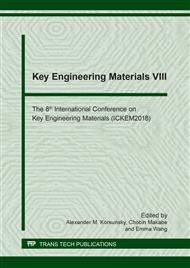[1]
S. Ye, AR. Rathmell, Z. Chen ,IE Stewart, BJ. Wiley, Metal nanowire networks: the next generation of transparent conductors, Adv Mater 26(39) (2014) 6670–6687.
DOI: 10.1002/adma.201402710
Google Scholar
[2]
B. Zhang et. Al, Electrical and optical properties of ITO and ITO: Zr transparent conducting films, Mat. Sci. Semicon. Proc. , (10) 6 (2007) 264–269.
Google Scholar
[3]
T. Minami et. al., Transparent conducting oxide semiconductors for transparent electrodes, Semiconductor Science and Technology. 20 (4) (2005) 35.
DOI: 10.1088/0268-1242/20/4/004
Google Scholar
[4]
J. Zhu, C. Kan, J. GuoWan, M. Han, G. Wang, High-yield synthesis of uniform Ag nanowires with high aspect ratios by introducing the long-chain PVP in an improved polyol process, Journal of Nanomaterials (2011).
DOI: 10.1155/2011/982547
Google Scholar
[5]
J. Lee, P. Lee, D. Lee, S. Seob Lee, and S. Ko., Large-scale synthesis and characterization of very long silver nanowires via successive multistep growth, Cryst. Growth De.,12 (2012) 5598−5605.
DOI: 10.1021/cg301119d
Google Scholar
[6]
D. S. Hecht, et. al., Emerging transparent electrodes based on thin films of carbon nanotubes, graphene, and metallic nanostructures, Adv. Mat., (23) 13 (2011) 1482–1513.
DOI: 10.1002/adma.201003188
Google Scholar
[7]
Z. Wu. et al., Transparent, conductive carbon nanotube films, Science 305, (2004) 1273-1276.
Google Scholar
[8]
S. Kirchmeyer and K. Reuter., Scientific importance, properties and growing applications of poly(3,4-ethylenedioxythiophene), J. Mater. Chem. vol. 15, p.2077–2088, (2005).
DOI: 10.1039/b417803n
Google Scholar
[9]
D. Dinh, K. Hui, K. Hui, P. Kumar, J. Singh, Silver nanowires: A promising transparent conducting electrode material for optoelectronic and electronic applications, Reviews in Advanced Sciences and Engineering, 2 (2013) 1–22.
DOI: 10.1166/rase.2013.1048
Google Scholar
[10]
N. De Guzman and M.D. Balela, Growth of ultralong Ag nanowires by electroless deposition in hot ethylene glycol for flexible transparent conducting electrodes, Journal of Nanomaterials, vol. 2017 (2017) 14.
DOI: 10.1155/2017/7896094
Google Scholar
[11]
Y. Xia et. al., On the polyol synthesis of silver nanostructures: glycolaldehyde as a reducing agent, Nano Letters 8 (7) (2008) 2077-(2081).
DOI: 10.1021/nl800910d
Google Scholar
[12]
N. De Guzman and M. D. Balela, Formation of silver nanowires in ethylene glycol for transparent conducting electrodes, Advanced Materials, Structures and Mechanical Engineering. 75 , (2016) 351-354.
DOI: 10.4028/www.scientific.net/kem.775.254
Google Scholar
[13]
Z. Li, C. Yang, R. Wang, High performance silver nanowire based transparent electrodes reinforced by EVA resin adhesive, Electronic Packaging Technology (ICEPT) (2016) 195-199.
DOI: 10.1109/icept.2016.7583118
Google Scholar
[14]
B. Hwang, M. Kim, S.M. Cho, S. Becker Y.H. Kim, and H. Kim, Embedded silver-nanowire electrode in an acrylic polymer–silicate nanoparticle composite for highly robust flexible devices., J. Appl. Polym. Sci., 134, (2017) 45203.
DOI: 10.1002/app.45203
Google Scholar


